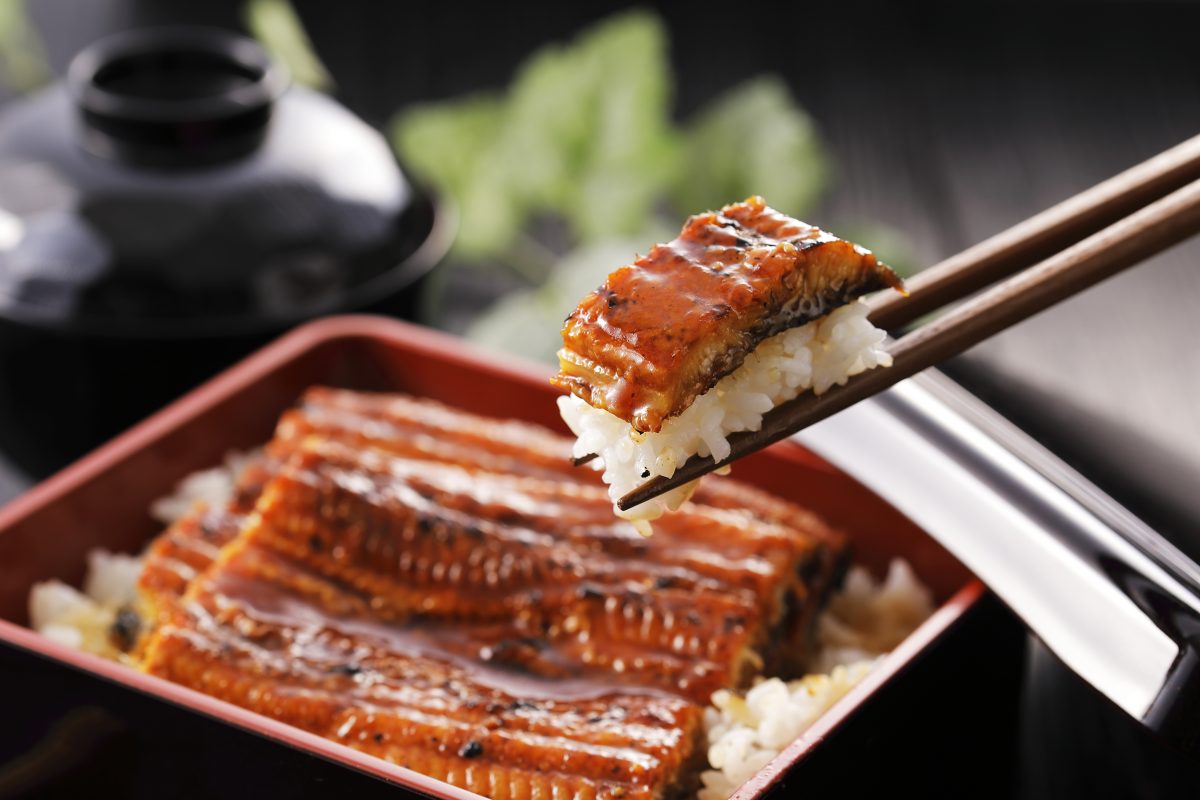Article 1: The Cultural Importance of Kabayaki and It’s Recent Decline
A Japanese Delicacy
On a specific summer day each year, the Japanese people ward off the notorious heat by eating unagi or eel. The occasion is “Doyo-ushinohi,” or Eel Day. Since ancient times, Japanese have considered eels a nutritious and energizing food. Nowadays, eel is considered a delicacy and artisanal eel restaurants are found throughout the country. In fact, in good eel restaurants, guests must wait for over one hour for their eel to be served, as the chef starts processing the live eels after the order is taken. The guests patiently enjoy waiting during preparation period, taking in the delicious smells coming from the broiled eel cooking in the kitchen.
The most popular form of eel is a dish called kabayaki. To prepare kabayaki, an eel is cut open from the belly (in Osaka), or from the back (in Tokyo), butterflied, cut into rectangular fillets, skewered, and dipped in a special soy sauce-based sauce before being grilled on charcoal. The sauce is often made according to a secret recipe of the restaurant and an important factor to enhance the taste. The kabayaki eel is served on top of a bowl of rice, and it is called “unadon.”
The Life Cycle of the Japanese Eel
Eels are familiar fish to Japanese people were abundantly found in rivers in the country. For centuries, the spawning site of the Japanese eel was unknown, despite the popularity of the fish. In 2006, a team of Japanese researchers at the University of Tokyo began the quest to find the origin of Japanese eels. Led by pioneer eel scientist Dr. Katsumi Tsukamoto, in 2009 the team identified their breeding site as the Mariana Trench in the Pacific Ocean, about 2,000 km south of Japan.
In the Mariana Trench, the eggs hatch and become transparent larvae (leptocephalus). These larvae travel westward, toward the Philippines in the Pacific Ocean, and then to the north. While traveling, they transform into glass eels. These glass eels may also find river habitats in Taiwan, China, South Korea, before they reach Japan.
When the glass eels swim upstream in the river, they become “yellow eels” with a yellowish white belly. After growing in a river or lake for 5 to 10 years, they mature into “silver eels”, named so due to their silved colored belly. The mature eels may travel down rivers, and through the Pacific Ocean, and back to the Mariana Trench spawning sites, but the process is still not well understood.
The Status of the Japanese Eel
Eels are made up of 19 different species, out of which four are commonly eaten: Japanese (Anguilla japonica), European (A. Anguilla), American (A, rostrata), and Indonesian (A. bicolor) eels. The eels that spawn in the Mariana Trench are Japanese eels. Traditionally, Japanese harvested wild caught eels from rivers. However, today most eel restaurants serve farmed eels, raised from glass eels caught in the rivers. Because wild caught glass eels must be obtained first to farm eels, this aquaculture method depends on wild Japanese eel populations, and overfishing will result in the depletion of resources. In fact, recent glass eel catch has been alarmingly low. Presently, Japanese eels are listed as endangered.
Concerned that in the future kabayaki eels will disappear from restaurant menus, a society called East Asia Eel Society was founded by Dr. Tsukamoto to exchange information on eels and find a solution to the decreasing eel population through research in a wide variety of fields including natural science, humanities and social science, culminating in a comprehensive “Eel Science” that could save the species.
As for the Japanese people, this is a serious business. The cultural and culinary significance of kabayaki eels is definitely here to stay. Join me in my next piece, where I will go into further detail about the endangered status of the Japanese eel and other eel species, as well as steps we can take to prevent the elimination of these important creatures.
